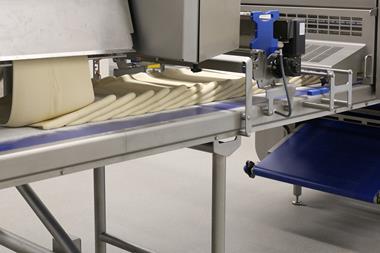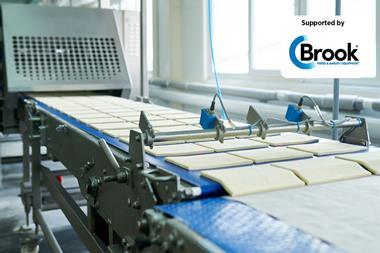Versatile sheeting and laminating equipment can help bakers create interesting textures, handle wet doughs and process a variety of inclusions, all while keeping doughs as stress-free as possible
When it comes to innovation, sheeting technology and lamination opens up a world of opportunities – and can help bakers keep up with the rapidly evolving demands of customers.
The hysteria sparked five years ago by Dominique Ansel Bakery in New York, when it crossed a doughnut with croissant dough, has spawned numerous hybrid laminated innovations including the Crookie and the Proissant (see box-out p43).
Sheeting equipment has also enabled bakers to produce the rustic-looking added-value products in such demand by retailers and consumers today, and premium bread products with interesting textures, such as flat rolls, ciabattas or pizza bases.
Today’s make-up equipment is also designed to handle and apply many different types of seeds, nuts and fruits. NPD is a priority in this area and supplier Rondo says it reinvests around 5% of its turnover year on year in research and development, working with customers from all around the world to follow new trends and develop solutions for processing them successfully.
Using a sheeting line allows almost any form of dough to be formed, cut, moulded (or coiled) and rounded. Such equipment can process doughs with very low or high percentages of liquid ingredients (42% to 90%-plus), explains Maarten Rijken, sales manager for DrieM, part of the Kaak Group.
“Given the uncertainty of what products will be a hit next year, there is an important role for flexible sheeting technology in the bakery,” he adds.
Rijken says that, for an equipment manufacturer, creating equipment that is versatile and can meet tomorrow’s demand is important. The company has had cases where it has installed equipment for one product, only for the business to be producing something entirely different the next year.
“Supporting our customers with this is absolutely vital. What we can achieve depends on the equipment, and we believe we will see technology develop further in flexibility while productivity and consistency increase.”
He adds that the current trends for high-quality and clean-label products will become even more important in the coming years, as will demand for single-portion goods.
And, at a time when factors including Brexit make it harder to recruit and retain staff, sheeting equipment can help to save labour, says Steve Merritt, managing director at supplier EPP, which last year completed a management buyout led by Merritt. The Epsom-based business has supplied equipment from specialist European manufacturers to British and Irish bakers for 45 years.
Equipment can also be expanded to meet the needs of a business as it grows, he adds.
The modular design of Koenig’s Menes machine, supplied by EPP in the UK, means it can be tailored to the individual needs of a business and modules such as seeding units, forming stations, cutting stations and retracting units can be integrated. Dough throughput can be up to 5,000kg an hour and the machine is available in working widths up to 1600mm depending on dough type. Dough sheets from as thin as 1mm up to 80mm can be achieved.
An important credential of modern equipment is minimising the stress sheeting can put dough under.
“Wheat dough, which combines a solid, liquid and gaseous structure, is a delicate system sensitive to chemical and physical energy inputs,” explains Merritt. “If the gas pore walls in the dough are subject to too big a deformation because of strong mechanical forces during processing, increased inner pressure will cause the membranes to disintegrate. Both the gas retention and water-binding capacities of the dough are then reduced, and this can also negatively influence the aroma.”
Koenig’s TwinSat has been designed to minimise the mechanical stressing of dough. The dough is not rolled down but gently pressed to size by a high-speed, gentle tamping movement. Eliminating different speeds in the dough layers ensures that the dough is not stressed to the same extent as when traditional techniques are used.
As more “difficult” doughs are developed to meet customer demands, sheeting equipment suppliers are working with bakers to overcome the hurdles these may present.
“When the time comes to introduce new products to plant production, we work with our customers to fine-tune the equipment and the recipe,” says Richard Tearle, general manager at Rondo.
His business has developed equipment including several lines with different capacities that will handle highly hydrated doughs without destroying their bubble structure.
Last year, the company launched the Rondobot rounding system for bread and rolls, which comprises an industrial robot, specialised tool sets and a purpose-built moulding table. It says the system can be integrated into existing, or new, bread and roll lines, and can emulate manual rounding “perfectly”, with 100% repeat-ability, says Rondo. It can reach up to 18,000 pieces an hour when producing 60g rolls.
The new Rondo Artisana bread line, which will be shown at this month’s IBA trade show in Munich, Germany, for the first time, has been developed for the gentle production of artisan bread products and is capable of processing up to 2,000 kg of dough an hour. It can be used to produce a wide range of products from cut breads such as ciabatta, long-moulded products such as baguettes, to round-moulded bread loaves and rolls.
Quite often, a full pastry make-up line can be the solution when other processes and technologies have been exhausted for coping with the product or production requirements, comments Ann Wells, group marketing director of supplier Brook Food.
She says the Polin pastry line is ideal for producing many goods; the dough can be processed automatically and continuously, thus reducing manual labour and increasing production.
For small bakery businesses looking to produce sheeted products, there are many options available, suggests Rijken at DrieM. Any product that can be made on a traditional dough make-up system can be produced on a sheeting line.
In some cases, it can be sensible to look at selecting sheeting equipment as your main production method, giving you the additional capability to create other products as well. If you buy traditional as well as sheeting equipment, it will add up to a much greater investment, he suggests.
However, an investment in any equipment is only profitable if a sufficient number of goods are produced on it.
The pastry or dough brake has been, and remains, an option for the smallest of bakery businesses, says Stan Cauvain, director of bakery consultancy BakeTran.
“The challenge for such operations has been and remains the control of paste processing temperature and the need for a resting period between individual sheeting steps, so as not to unduly stress the paste and damage the dough layers.”
Recovery ideally has to be temperature-controlled, so the common practice is
to transfer the paste to a refrigerator – which may be a big challenge for small bakery businesses.
Rondo also says it has sheeting solutions for every application, from a hotel kitchen to high-volume industrial production. Its Econom range is popular with artisan and craft bakers all over the world.
When it comes to dough preparation, whatever the size of your operation, sheeting equipment is proving itself to be the baker’s flexible friend.
Peeling back layers: a guide to lamination
Bakery scientist Stan Cauvain, director of BakeTran, discusses the terminology used for laminated products.
“Classically, the English method of lamination starts with three dough and two fat layers, while the French method starts with two dough layers and one fat layer.
“The English method is best suited to small-scale production, while the French method can be used on a small scale, but is ideally suited to large-scale production.
“The starting ratio of dough to fat layers will influence the rate at which the number of dough layers increases during sheeting and laminating, with the number of ‘theoretical fat layers’ increasing faster with the English method.
“We refer to ‘theoretical fat layers’ because, while the aim in laminated products is to have alternate and discrete layers of fat and dough, there is no certainty that will be the case, due to variations in the layers’ integrity.
“The terms mean very different things to different parts of the world. For example, traditionally the Danes would not recognise the concept of Danish pastry, as this is an Americanism. In common parlance the concept of Danish pastry refers to puff pastry that has been enriched with sugar and egg and will be yeast-raised.
“Meanwhile, Danish pastries and croissants have to be proved and the number of fat layers is therefore usually lower than that of puff pastry.”
CASE STUDY: Pophams Bakery
Pophams Bakery launched in October 2017 after founder Ollie Gold decided London was lacking in really good laminated pastries.
Gold, girlfriend Lucy McWhirter and friends converted a former chemist’s shop into a stylish bakery, giving it a Scandinavian style and look.
The bakery, situated off Popham Street in Islington, north London, focuses on croissants with unique flavour combinations.
These include the bakery’s best-selling bacon maple croissants, rosemary & sea salt twists, or more exotic options such as goat’s cheese custard; raspberry & walnut; walnut, fig & blue cheese; coconut & white rum; or peanut butter, jam & banana pastries.
Menus are changed every couple of months, with seasonal specials and prices ranging from £2 for a plain croissant to £4.20 for an exotic option.
At the moment Pophams’ three bakers, led by head baker Florian Grama, work flat out just to keep up with demand, and may sell out of certain croissants by 12.30pm on busy days.
Croissant dough is prepared the day before and given its final touches the next morning (around 18 to 20 hours later). The company has invested in a new Tekno Stamap dough sheeter to prepare the dough.
The bakery also offers freshly baked sourdough breads alongside speciality coffee.
Lamination at heart of NPD
Lamination was at the heart of the hybrid bakery products craze, which started with Dominique Ansel’s Cronut, made with laminated dough, in 2013.
For the Cronut, dough was rolled together with a block of chilled butter to form layers, with the addition of a little egg white and cream, similar to croissant dough with a bit of Danish.
The Cronut spawned further hybrid laminated innovations, such as the Crookie, a croissant stuffed with cookies – specifically, Double Stuffed Oreos – as well as the Proissant, a pretzel and a croissant hybrid.
Things have gone a bit quiet in the past couple of years on the hybrid bakery lamination innovation front, but that is not to say laminated products are out of fashion. Délifrance recently completed a year-long £4m expansion of its Viennoiserie production facility in Leicester. The expansion, which doubles its capacity, comes as UK interest in Viennoiserie grows, driven by factors including increased demand for breakfast on-the-go and convenient snacking products, according to Délifrance UK managing director Andrew Cole.
In an evolving marketplace it is key to stay ahead of customer demand, providing added value at the right cost, he says. What is an aspirational and top-tier product today, will soon become mass-market.
The expanded Viennoiserie site at Wigston includes a finishing room, with machinery to inject fillings into fresh products such as croissants and to top them. This will allow Délifrance to offer seasonal specials, such as mincemeat-filled croissants, or croissants with liquid savoury fillings. The facility is set to come online early next year.
So, lamination is still a hotbed for NPD, with work across the industry on anything from salt to fat reduction to the use of non-wheat doughs and, of course, innovative flavour combinations.
The challenge with any new type of dough is to work out a suitable formulation, says BakeTran director Stan Cauvain. He adds that there is no reason why nutritious materials (such as chickpea flour) cannot be used in laminated products – the challenge will be to find the most appropriate changes in process technology to accommodate the recipe and the rheological properties of the paste.
“We have extensive knowledge of handling non-wheat flours as the growth of free-from products,” says Richard Tearle of Rondo. “Challenges differ with each type of flour and it is a matter of finding the best solutions by experimenting with recipe and equipment.”
The spotlight is very much on reducing the level of fat in products, says Cauvain, who is co-author of a review on the issue of reducing the level of fat in laminated products. Work between BakeTran and Australian universities has shown, among other things, that reductions in laminating fat would require compensatory changes in processing, he says. It is not as simple as reducing the overall fat.
CASE STUDY: Bells Professional Pastry
Family company Bells, based in Shotts, Lanarkshire, supplies major retailers in Scotland and food manufacturers in the UK and Ireland.
The bakery employs 200 people in its three sites: a distribution centre and depot; a savoury production site; and a pastry production site. Around 80% of its business is the supply of Bells branded products, such as Scotch pies, steak pies and savouries, as well as some cakes.
It set up the Bells Professional Pastry division in 2016, and that business is divided into three main areas: ‘Roll & Cut’ supplies blocks of puff pastry direct to bakers, or wholesale as own-label products, such as Bako Puff Pastry; its ‘Specialist’ range offers pastry shapes, such as triangles and lattices, to meat, poultry and fish manufacturers; and ‘Fill & Bake’ includes products such as pre-lined foils for making pies with matching pie lids.
James Drury, pastry business manager at Bells says: “We use a range of mixing methods for producing puff pastry. The traditional French way, where you layer and laminate fat through the dough, tends to produce a flakier pastry with visible layers.”
The company’s Scotch method is also popular, he says, where hard fat is mixed into a soft dough, which is then laminated, and creates pockets to produce a consistent and reliable rise. Drury says: “It is very popular for en croute products, Wellingtons and sausage rolls, as the pastry has a closer and less flaky texture.”
The company supplies savoury product manufacturers but wants to do more work with desserts manufacturers. Its low-salt puff pastry is already often used by customers in sweet products such as apple turnovers and fruit pies.
As part of NPD, Bells has looked at adding inclusions such as chilli, thyme and rosemary to pastry. However, the challenge is the practicalities of producing the volumes required. The customer needs to commit to take a full production run of around eight to ten tonnes as a whole shift will be needed to produce a recipe.
When using seeds as inclusions, the business has to be careful that the seeds chosen are not too oily. Sesame and onion seed work well, but can be allergenic to some.
The prices of all commodities are going up, which is an issue for the business. The company only uses RSPO-certified margarines and the prices of these also fluctuate.
“We get requests for butter-enriched pastry and all-butter pastry, but the price of butter has risen so steeply recently that it is not economically viable for all product briefs,” says Drury.
“We also get asked to look at gluten-free options, but it has never really taken off in a big way; our customers seem to prefer traditional classics.”





























No comments yet